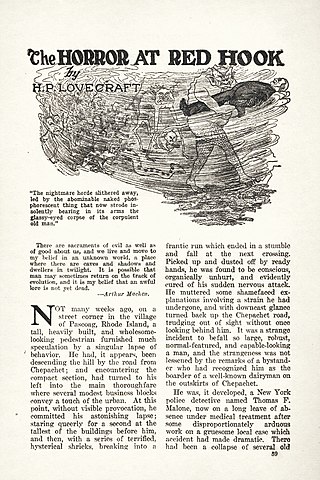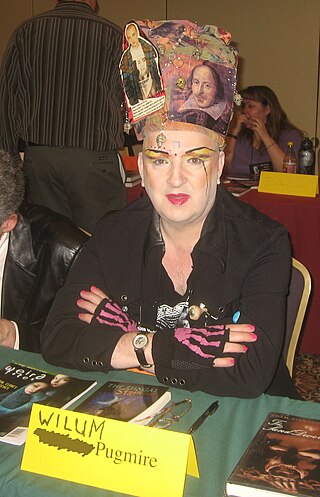
The Cthulhu Mythos is a mythopoeia and a shared fictional universe, originating in the works of American horror writer H. P. Lovecraft. The term was coined by August Derleth, a contemporary correspondent and protégé of Lovecraft, to identify the settings, tropes, and lore that were employed by Lovecraft and his literary successors. The name "Cthulhu" derives from the central creature in Lovecraft's seminal short story "The Call of Cthulhu", first published in the pulp magazine Weird Tales in 1928.

Howard Phillips Lovecraft was an American writer of weird, science, fantasy, and horror fiction. He is best known for his creation of the Cthulhu Mythos.

The Necronomicon, also referred to as the Book of the Dead, or under a purported original Arabic title of Kitab al-Azif, is a fictional grimoire appearing in stories by the horror writer H. P. Lovecraft and his followers. It was first mentioned in Lovecraft's 1924 short story "The Hound", written in 1922, though its purported author, the "Mad Arab" Abdul Alhazred, had been quoted a year earlier in Lovecraft's "The Nameless City". Among other things, the work contains an account of the Old Ones, their history, and the means for summoning them.

Cthulhu is a fictional cosmic entity created by writer H. P. Lovecraft. It was first introduced in his short story "The Call of Cthulhu", published by the American pulp magazine Weird Tales in 1928. Considered a Great Old One within the pantheon of Lovecraftian cosmic entities, this creature has since been featured in numerous popular culture references. Lovecraft depicts it as a gigantic entity worshipped by cultists, in the shape of a green octopus, dragon, and a caricature of human form. The Lovecraft-inspired universe, the Cthulhu Mythos, where it exists with its fellow entities, is named after it.
Miskatonic University is a fictional university located in Arkham, a fictional town in Essex County, Massachusetts. It is named after the Miskatonic River. After first appearing in H. P. Lovecraft's 1922 story "Herbert West–Reanimator", the school appeared in numerous Cthulhu Mythos stories by Lovecraft and other writers. The story "The Dunwich Horror" implies that Miskatonic University is a highly prestigious university, on par with Harvard University, and that Harvard and Miskatonic are the two most popular schools for the children of the Massachusetts "Old Gentry". The university also appears in role-playing games and board games based on the mythos.

"The Call of Cthulhu" is a short story by American writer H. P. Lovecraft. Written in the summer of 1926, it was first published in the pulp magazine Weird Tales in February 1928.

Frank Belknap Long was an American writer of horror fiction, fantasy, science fiction, poetry, gothic romance, comic books, and non-fiction. Though his writing career spanned seven decades, he is best known for his horror and science fiction short stories, including early contributions to the Cthulhu Mythos. During his life, Long received the World Fantasy Award for Life Achievement, the Bram Stoker Award for Lifetime Achievement, and the First Fandom Hall of Fame Award (1977).

Sunand Tryambak Joshi is an American literary critic whose work has largely focused on weird and fantastic fiction, especially the life and work of H. P. Lovecraft and associated writers.

"The Haunter of the Dark" is a horror short story by American author H. P. Lovecraft, written between 5–9 November 1935 and published in the December 1936 edition of Weird Tales. It was the last written of the author's known works, and is part of the Cthulhu Mythos. The epigraph to the story is the second stanza of Lovecraft's 1917 poem "Nemesis".

Lovecraftian horror, sometimes used interchangeably with "cosmic horror", is a subgenre of horror fiction and weird fiction that emphasizes the horror of the unknowable and incomprehensible more than gore or other elements of shock. It is named after American author H. P. Lovecraft (1890–1937). His work emphasizes themes of cosmic dread, forbidden and dangerous knowledge, madness, non-human influences on humanity, religion and superstition, fate and inevitability, and the risks associated with scientific discoveries, which are now associated with Lovecraftian horror as a subgenre. The cosmic themes of Lovecraftian horror can also be found in other media, notably horror films, horror games, and comics.

"The Horror at Red Hook" is a short story by American writer H. P. Lovecraft, written on August 1–2, 1925. "Red Hook" is a transitional tale, situated between the author's earlier work and the later Cthulhu Mythos. Although the story depicts a sinister cult, this cult offers a conventionally occult devil-worshipping threat, rather than the cosmic threat depicted in his later work. Living in poverty in the slum of Red Hook at the time of writing, Lovecraft was at this time urgently attempting to widen his markets in the pulp magazines. By having an unusually proactive Irish New York police detective as his protagonist, he hoped for a swift sale to a detective pulp, which would have opened up a new market other than his usual Weird Tales magazine. He did not get such a sale, and had to fall back on Weird Tales. "Red Hook" was thus first published in the January 1927 issue of Weird Tales.
Peter H. Cannon is an H. P. Lovecraft scholar and an author of Cthulhu Mythos fiction. Cannon works as an editor for Publishers Weekly, specializing in thrillers and mystery. He lives in New York City and is married with three children.

Wilum Hopfrog Pugmire, was a writer of weird fiction and horror fiction based in Seattle, Washington. His works typically were published as W. H. Pugmire and his fiction often paid homage to the lore of Lovecraftian horror. Lovecraft scholar, biographer, and literary executor S. T. Joshi described Pugmire in 2011 as "the prose-poet of the horror/fantasy field; he may be the best prose-poet we have," and "perhaps the leading Lovecraftian author writing today."

Joseph Vernon Shea (1912–1981) was an American author of horror, fantasy, poetry, and essays; and a correspondent of H. P. Lovecraft, Clark Ashton Smith, and August Derleth.

"History of the Necronomicon" is a short text written by H. P. Lovecraft in 1927, and published in 1938. It describes the origins of the fictional book of the same name: the occult grimoire Necronomicon, a now-famous element of some of his stories. The short text purports to be non-fiction, adding to the appearance of "pseudo-authenticity" which Lovecraft valued in building his Cthulhu Mythos oeuvre. Accordingly, it supposes the history of the Necronomicon as the inspiration for Robert W. Chambers' The King in Yellow, which concerns a book that overthrows the minds of those who read it.

Joseph S. Pulver Sr. was an author and poet, much of whose work falls within the horror fiction, noir fiction / hardboiled, and dark fantasy genres. He lived in Germany, and died from COPD and other issues in a German hospital on April 24, 2020.

This article provides a list of cultural references to the work of author H. P. Lovecraft. These references are collectively known as the Cthulhu Mythos. For works that are stylistically Lovecraftian, including comics and film adaptations influenced by Lovecraft, see Lovecraftian horror.
Ann K. Schwader is an American poet and writer of short fiction based in Westminster, Colorado. Schwader is a grand master of the Science Fiction & Fantasy Poetry Association, a multiple winner of the Rhysling Awards, and has been called one of the "top poets" in the speculative poetry genre.
Lovecraft fandom, Lovecraftian fandom or Cthulhu Mythos fandom refers to is an international, informal community of fans of the works H. P. Lovecraft, especially of the Cthulhu Mythos and the Lovecraftian horror.
Lovecraft studies is the body of research that has emerged surrounding the works of H. P. Lovecraft. It began with the dissemination of Lovecraft's works by Arkham House during the decades after his death. The scholars in the field sought to establish Lovecraft as a major author of American speculative fiction during its foundational period in the 1970s. After the death of August Derleth, the founder of Arkham House, the field shifted in a direction away from the one that he promoted. L. Sprague de Camp's biography of Lovecraft emerged during this time. While criticized by portions of the fans and scholarship, it played a significant role in his literary rise. During the late 1970s and early 1980s, the scholars were split between traditionalist who supported Derleth's positions on Lovecraft and those who did not. The 1980s and 1990s featured an expansion of the field, including the H. P. Lovecraft Centennial Conference. Memorials to Lovecraft began to appear in his home city of Providence, Rhode Island and his works began to be published by Penguin Classics. S. T. Joshi, a major figure in the field, wrote a biography of Lovecraft that superseded de Camp's work. In 2008, the Library of America, published a volume of Lovecraft's works that solidified the perception that H. P. Lovecraft was now part of the western canon. The NecronomiCon Providence, a biannual scholarly and fan conference managed by the Lovecraft Arts and Sciences organization, began to be held in 2013.









